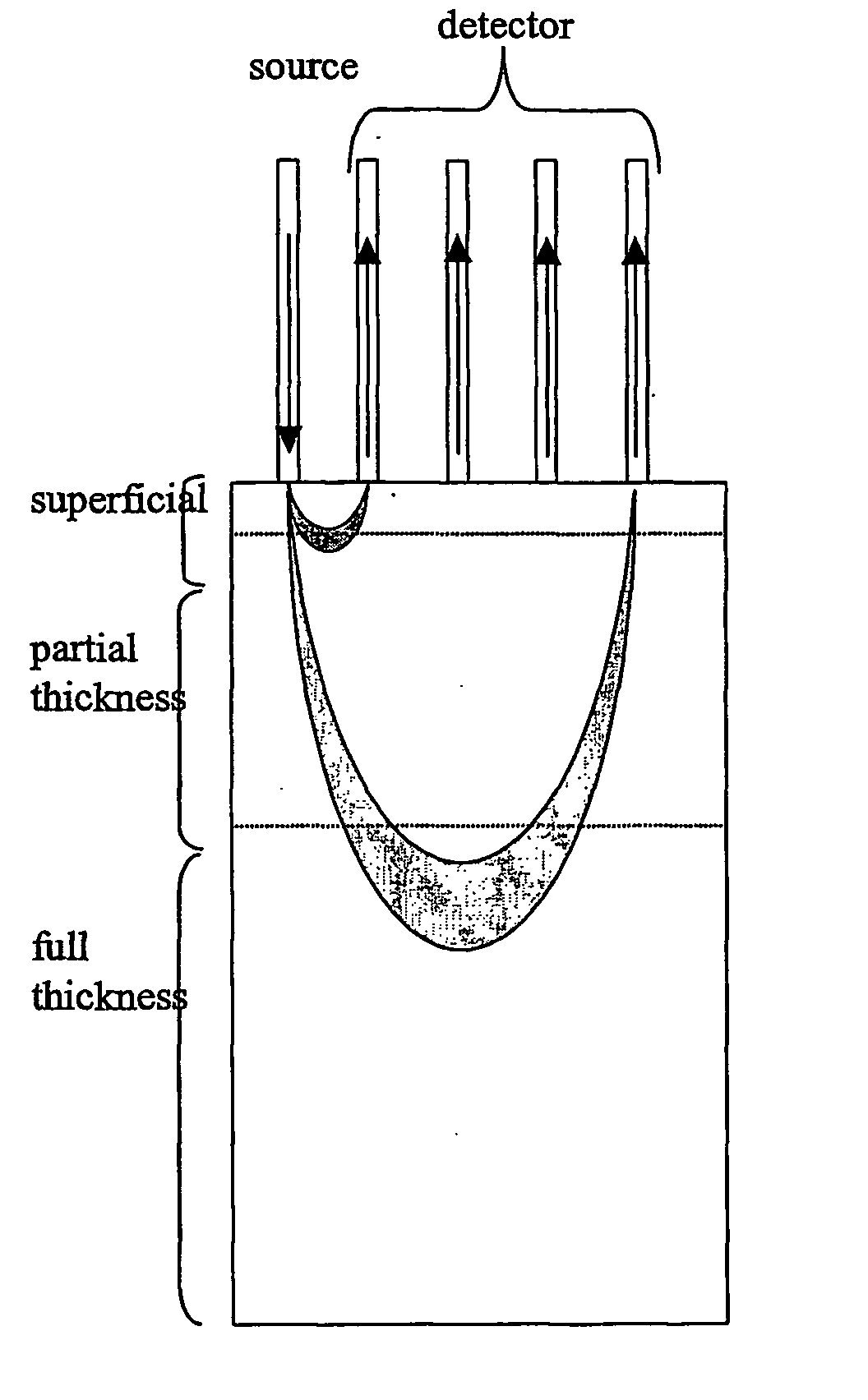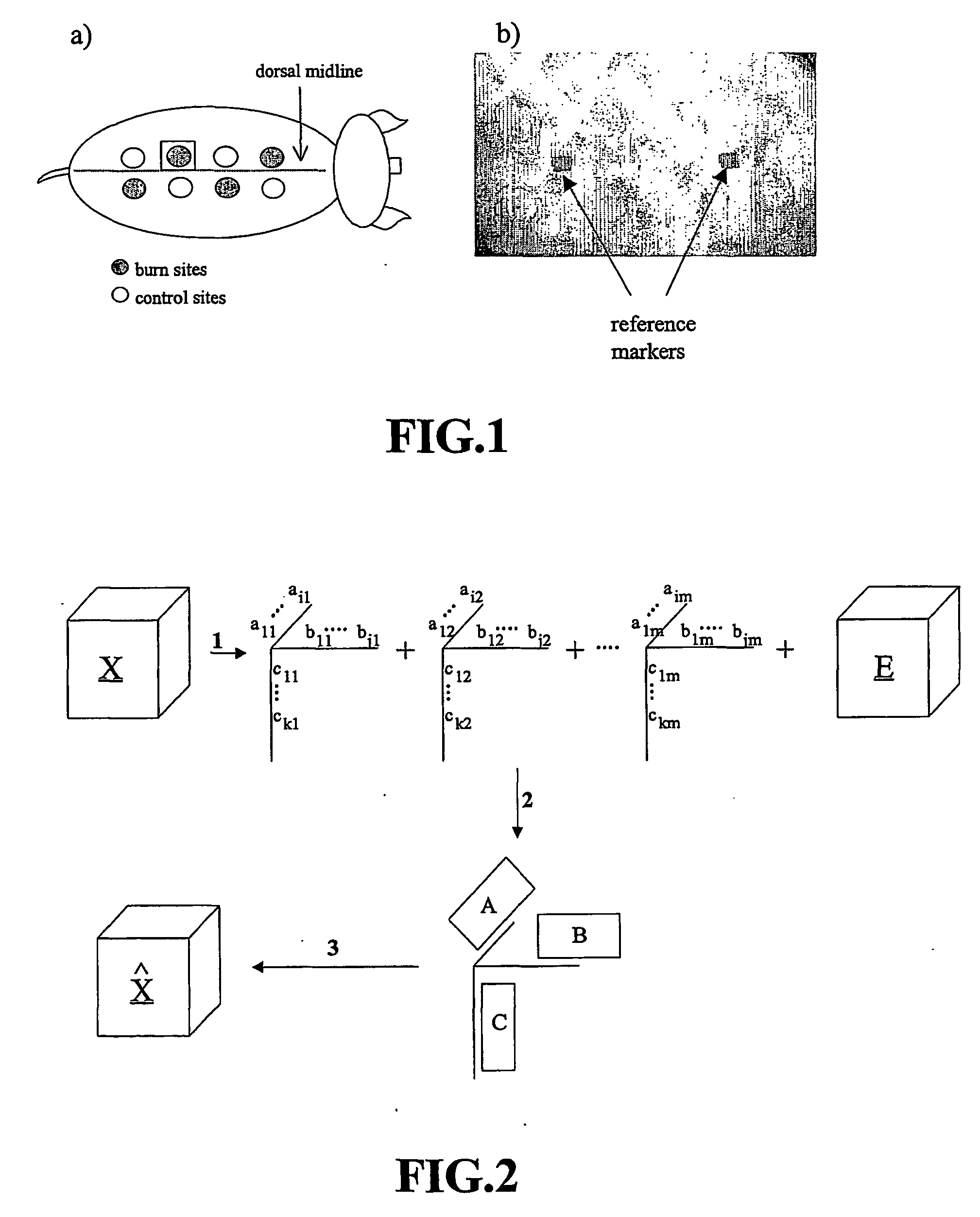Visible-near infrared spectroscopy in burn injury assessment
a burn injury and infrared spectroscopy technology, applied in the field of medical devices, can solve the problems of scarring, tissue damage, even death, accurate assessment of burn severity remains a problem for burn specialists, and the ability to distinguish between burns that will heal on their own versus those that will require surgical intervention is particularly challenging
- Summary
- Abstract
- Description
- Claims
- Application Information
AI Technical Summary
Problems solved by technology
Method used
Image
Examples
example i
[0035] Following a 10 day acclimatization period, adult Yorkshire cross swine weighing between 40 and 50 kg were premedicated with an intramuscular injection of midazolam (0.3 mg / kg), atropine (0.02 mg / kg), and ketamine (20 mg / kg). Anesthesia was then induced by mask and the pigs were intubated and mechanically ventilated. Isoflurane (1.5-2.5%), was delivered through the ventilator (via 40-60% oxygen mixed with medical air at 3.0 Umin) to maintain anesthesia for the duration of the experiment. Systemic oxygen saturation, heart rate, and blood pressure were monitored throughout the experiment. Core body temperature was maintained at 39.0° C.±0.5° C. Blood samples for blood gas and electrolyte analyses were acquired prior to thermal injury and every hour thereafter.
[0036] Following anesthesia, both sides of the dorsal midline were shaved and eight sites, each 3 cm in diameter, were marked on the back of the animal using a custom-made template. Four of the sites were loca...
example ii
Visible-Near Infrared Spectroscopy
[0039] Visible-near infrared spectra were collected with an NIRSystems 6500 (Foss, Silver Springs, Mass.) spectrometer using a custom bifurcated fiber optic bundle (Fiberguide Industries, Stirling, N.J.). The multifiber probe consisted of five optical fibers, one to illuminate the tissue and four to collected the remitted light. The illumination and collection fibers were 2 m in length with a core diameter of 600 and 200 μm, respectively. The fiber order at the head of the probe were placed in a co-linear arrangement beginning with the illumination and subsequent collection fibers spaced 1.5 mm from each other. Therefore, the distance of the four collection fiber from the illumination source were 1.5, 3, 4.5, and 6 mm. The illumination optical fiber was coupled to a 100 W quartz tungsten halogen white light source (Oriel, Strattford, Conn.). The four collection optical fibers were placed at the entrance of an imaging spectragraph (Sciencetech Inc.,...
example iii
Multivariate Data Processing
[0045] A time series of near infrared spectra were collected from selected sites on the dorsa of 5 animals. The first time point in the series was acquired prior to thermal injury. Subsequent points in the time series were acquired at fixed time intervals after the injury. The experimental design results in a rich set of data consisting of many variables (reflectance response over the 400-2500 nm wavelength range) observed on several occasions. (longitudinal measurements) and measured at several sites or groups (cross-sectional data) over a sample population of 5 animals. Parallel factor analysis is used to try to isolate and recover the spatial, spectral and temporal changes in reflectance of the skin due to the varying degree of thermal insult.
[0046] Parallel factor analysis is used to explore the time series of spectral data by identifying the “pure” molecular species that contribute to the spectra and determining how these “pure” species are affecte...
PUM
 Login to View More
Login to View More Abstract
Description
Claims
Application Information
 Login to View More
Login to View More - R&D
- Intellectual Property
- Life Sciences
- Materials
- Tech Scout
- Unparalleled Data Quality
- Higher Quality Content
- 60% Fewer Hallucinations
Browse by: Latest US Patents, China's latest patents, Technical Efficacy Thesaurus, Application Domain, Technology Topic, Popular Technical Reports.
© 2025 PatSnap. All rights reserved.Legal|Privacy policy|Modern Slavery Act Transparency Statement|Sitemap|About US| Contact US: help@patsnap.com



